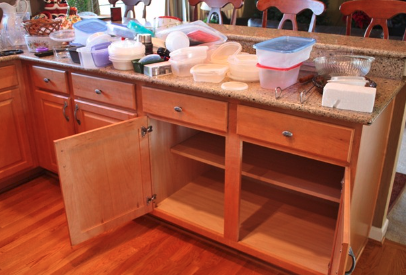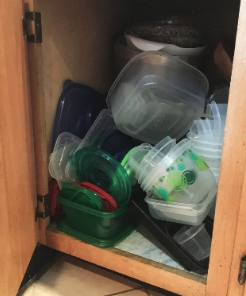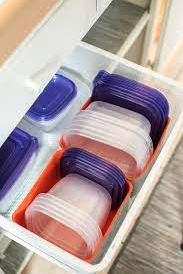Have you ever heard that your kitchen is the heart of your home? The reason for this is that throughout our home there are many bedrooms and living spaces, but only one kitchen. Since this is the case, it’s so important to make sure that this space is organized and simplified.
Before we get to the HOW of the organization and simplification of this part of your home, let’s dive into why this really matters on a deeper level.
3 Benefits of Having an Organized Kitchen
- You save money 💸
Yep, you read that right. By taking the time to organize your home, you put more money back in your pocket. How?
Through the organization process, you’ll take inventory of everything you have in your cabinets – I’m talking every single pot, pan, spatula and random piece of silverware you have tucked away – you’ll take inventory of all of it and determine what’s gonna stay and what’s gonna go.
During this, you’ll become aware of exactly what you have in your kitchen – things you forgot you had and things you don’t need – and you’ll be less likely to buy duplicate items. This goes for your fridge, freezer and pantry too – we’re not going to dive into those specifically in this blog post, but just know that the 4 steps you’re about to read can really apply to any part of your home.
- You save time ⏰
Once you take inventory and become aware of everything you have in your kitchen, just like it saves you money, it also saves you time!
Think about it: how many times have you been cooking up a meal for your family and you end up spending more time running around searching for that specific pan you need or that certain seasoning that the recipe calls for than ACTUALLY cooking?
Yeah, that scenario 👆🏼has happened to all of us.
When everything has a designated space, you can save time in the cooking and cleaning process.
- You improve your mental health 👏🏼
Did you know that visual clutter negatively affects your mental health? This is one of, if not THE MOST, important reason we believe all spaces should be organized and simplified.
Picture this: after a long, hard day of work you head to your fridge to grab your favorite afternoon beverage. As you turn the corner into your kitchen, you’re greeted with spotless counters, an empty sink and everything is tucked away in its designated spot.
You grab your favorite glass out of your perfectly organized cabinet and suddenly, the tired feeling that the work day brought was immediately replaced with a peaceful, calm and harmonized feeling. You’re able to go about your evening feeling energized as you spend time with your family, all because you invested the time to organize and simplify the heart of your home.
On the flip side of that picture, your counters are cluttered with loose mail, cabinets are filled to the brim with items you never use, the sink is full of dishes from the day before and when you walk in you’re overwhelmed visually. All of which can bring on additional stress, the inability to focus, lack of sleep and unproductivity 👎🏼
Out of the two of those scenarios, I’m pretty confident that you’d much rather experience picture #1.
So, let’s make that picture your reality by getting into the HOW.
4 Key Steps to Organizing Your Kitchen Cabinets
1. First Things First: Take Inventory
Before you get into the actual process of organizing your kitchen, the first thing you’ll want to do is take a total inventory of everything you have. To do this, I suggest emptying out every single cabinet and drawer. It’ll look crazy at first and might drive you nuts, but trust the process! Lay everrryyyything out so you can visually see every item you have.

From there, I suggest making 3 piles:
- Keep
These are items you can’t live without. Your tried and true pots, pans, utensils, etc. Maybe some of these items are sentimental or were given as a gift and you can’t part with them. Be honest with yourself here – do you REALLY need to keep it?
- Donate
These are items that are in great condition and could benefit someone, but you don’t necessarily need them. Maybe you have some duplicate utensils, so you decide to keep your favorites and donate the rest. Or maybe you held onto those plates from your first apartment and it’s time to let them go. Again, be honest with yourself!
- Toss
And finally, these are the items that have been heavily used and served their time. You don’t use them and you don’t feel comfortable giving them away. I’m currently envisioning the cup that is stained and dirtied from years of use – go ahead and toss that thing!
Once you’ve conducted an inventory, it’s time to get into the good stuff.
2. Next, Categorize Your Items
Now it’s time to dissect your “keep” pile and categorize your items. For this, I suggest moving each category into corresponding piles.
Here are some of the most common categories of items within a kitchen:
- Regular drinking cups
- Coffee mugs
- Barware, such as wine glasses, cocktail cups, etc.
- Plates
- Bowls
- Pots + Pans
- Other cookware, such as baking sheets, casserole dishes, mixing bowls, etc.
- Cooking utensils, such as spatulas, tongs, whisks, etc.
- Silverware
- Food storage containers
3. Then, Determine the Layout of Your Kitchen
Now that you have all of your items categorized, before you actually start putting things away, I want you to think about the layout of your kitchen.
Think about when you’re cooking and what feels natural for you. What cabinet do you tend to reach for? What drawer are you drawn to?
The answer to those questions will determine HOW you actually organize your items.
Generally speaking, your everyday dishes, glasses and silverware will likely go closest to your dishwasher. Your pots, pans and other cookware will go in cabinets nearest to the stove – for this make sure you’re keeping your bakeware, casserole dishes and mixing bowls together. This will keep things easy for you when it comes time to cook!
Your cooking utensils and silverware will also go in a drawer nearest to the stove.
While there are general guidelines to follow when it comes to kitchen organization, you want to make sure that you’re placing your items in the spots that make the most sense for YOU, so that:
- you’re more productive when using the space by knowing exactly where everything is AND
- enjoy the time you’re spending there instead of feeling frustrated when things are all mixed up.
In this step, go ahead and identify which cabinets (upper + lower) and drawers should be used for which items and let’s get to it.
4. Finally, ORGANIZE!
Now that you’ve taken inventory, categorized your items and fully evaluated how you use your kitchen, it’s time for the fun part – the actual organizing!
While I know it may seem like you have to do a lot of things before you even get to this part, trust me when I say that each part leading up to this point is crucial to creating a space that is easy to maintain for the long haul.
Best Practices for Organizing Your Kitchen Cabinets:
- Dinnerware
For your everyday plates and bowls, it’s best to stack these in a reachable upper cabinet next to each other, so they’re easily accessible on a daily basis.
If your cabinets don’t allow for much stacking, one of my favorite hacks is incorporating a rack like this in your cabinets to maximize the space!
- Drinkware
Most of us have multiple types of drinkware in our home – everyday cups, coffee mugs and barware. You can opt to have all of your drinkware in one cabinet if you have a lot of space OR you can decide to separate them among your kitchen or living spaces where they make the most sense.
For example, you may want to house your coffee mugs in the cabinet above your coffee station in your kitchen, while your everyday drinking glasses are lined alongside your everyday dinnerware and your barware is tucked away in an armoire or bar cart in your living room.
Whatever you choose, make sure you line or stack your cups in a way that’s visually appealing to achieve the complete organized look.
- Cookware (including pots, pans, baking sheets, casserole dishes, etc.)
Traditionally, your cookware is located in lower cabinets on either side of your stove depending on the layout of your kitchen. When organizing these items, you may have to get creative! A lot of times, these items can be odd shaped and require you to store them in ways that aren’t so visually appealing.
While your pots and pans are usually pretty stackable amongst each other, one thing I find to be a little pesky in the organization process are the lids to all of those pieces. A lid holder can make this much easier for you!
Getting rid of duplicates, especially when it comes to your cookware, is going to be one of the best things you can do to ensure an organized kitchen. That’s why we start with that!
- Food Storage Containers (aka Tupperware)
This one can be a doozy because there are SO MANY pieces when it comes to food storage containers due to the multiple sizes and lid options. We can’t live without it, so if you’ve gotta have it, let’s at least make the storage of it not so crazy.
WHAT WE DON’T WANT VS. WHAT WE DO WANT:
One of the easiest ways to achieve this level of organization is to invest in the food storage containers with lids that snap onto the bottom of the containers, so that you aren’t having to find more space for both the container and the lid.
Best Practices for Organizing Your Kitchen Drawers:
- Silverware and Cooking Utensils
Silverware should be your easiest drawer to organize, as long as you have one of those handy dandy separators.
On the other day, your cooking utensils drawer can get crazy if you aren’t careful! This is one of those main categories where you’ll be happy you discarded the duplicates and only kept what you really need.
Just like your silverware, this drawer will be best to organize with a separator. This one is adjustable so you can adjust it to the size of your specific drawer.
If you have a few utensils that you find yourself using almost everyday, I would suggest displaying those on your counter in an aesthetically pleasing jar, so you can easily access them while they double as a piece of kitchen decor!
When you thoroughly implement these 4 steps, you can have a kitchen that creates a peaceful, calm and harmonized feeling each time you step into it!
If you wish to achieve this type of harmony in your life, but struggle to do it yourself, that’s what we’re here for! Click here to connect with our team to see how we can serve you best.

